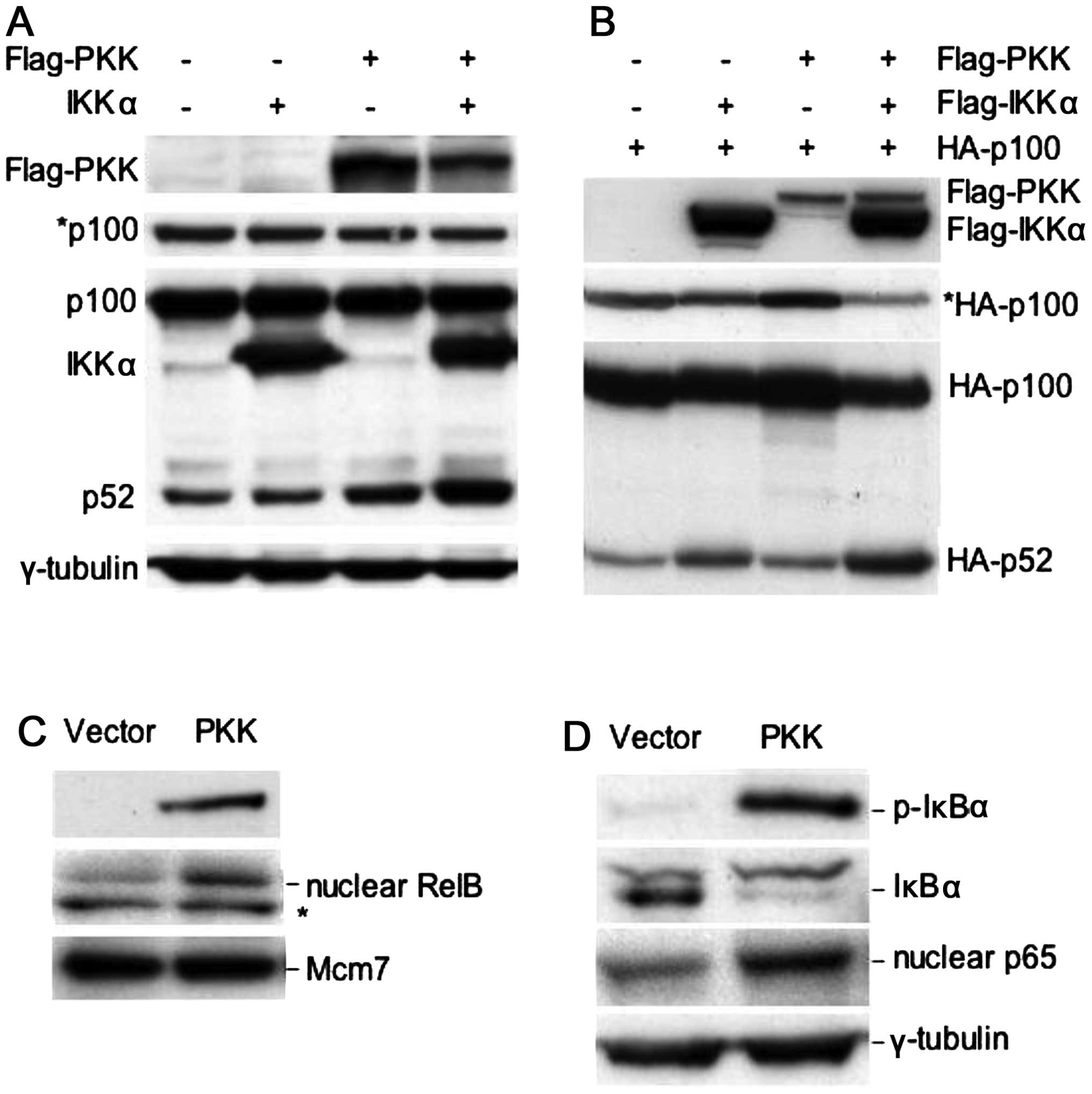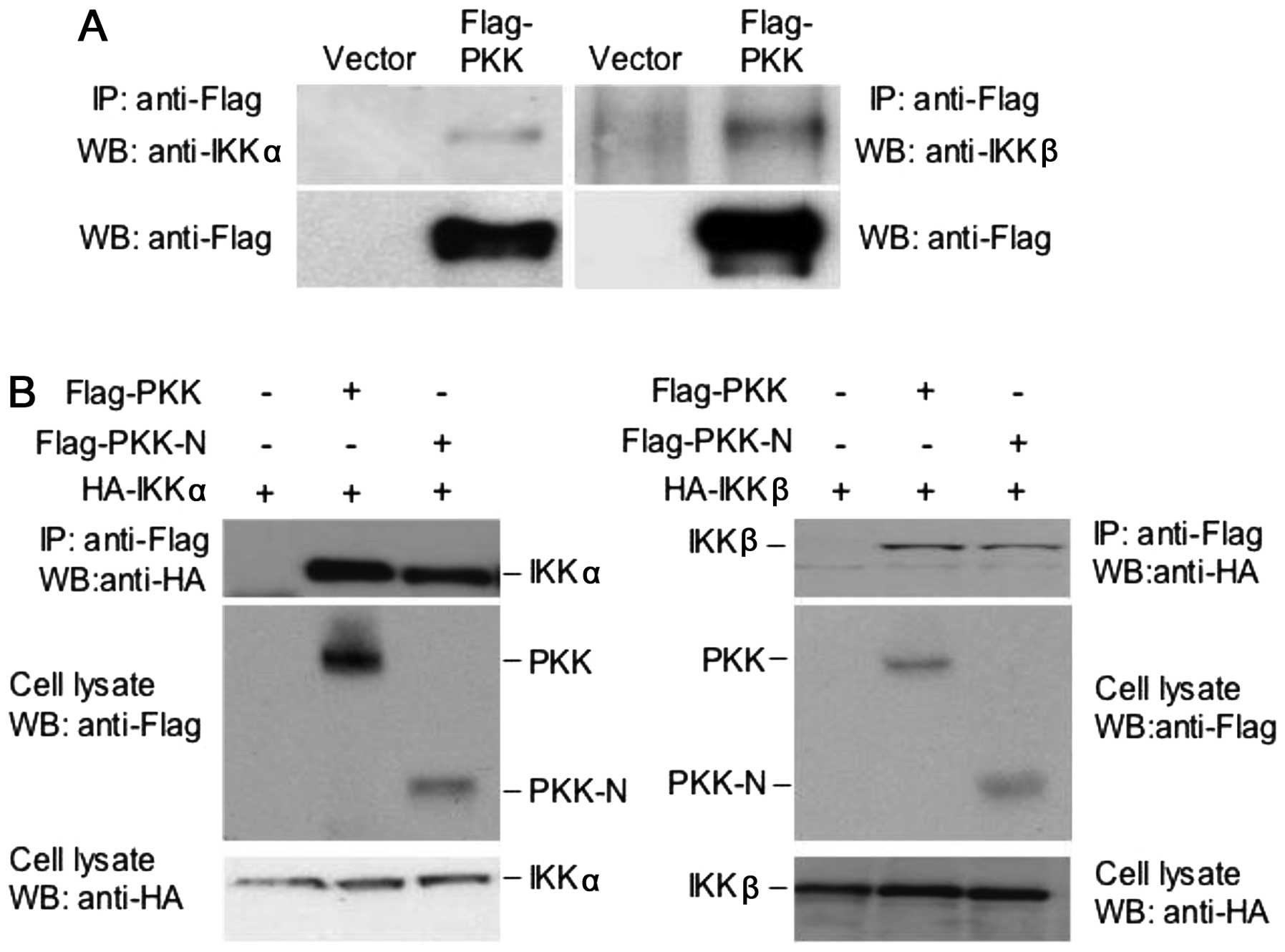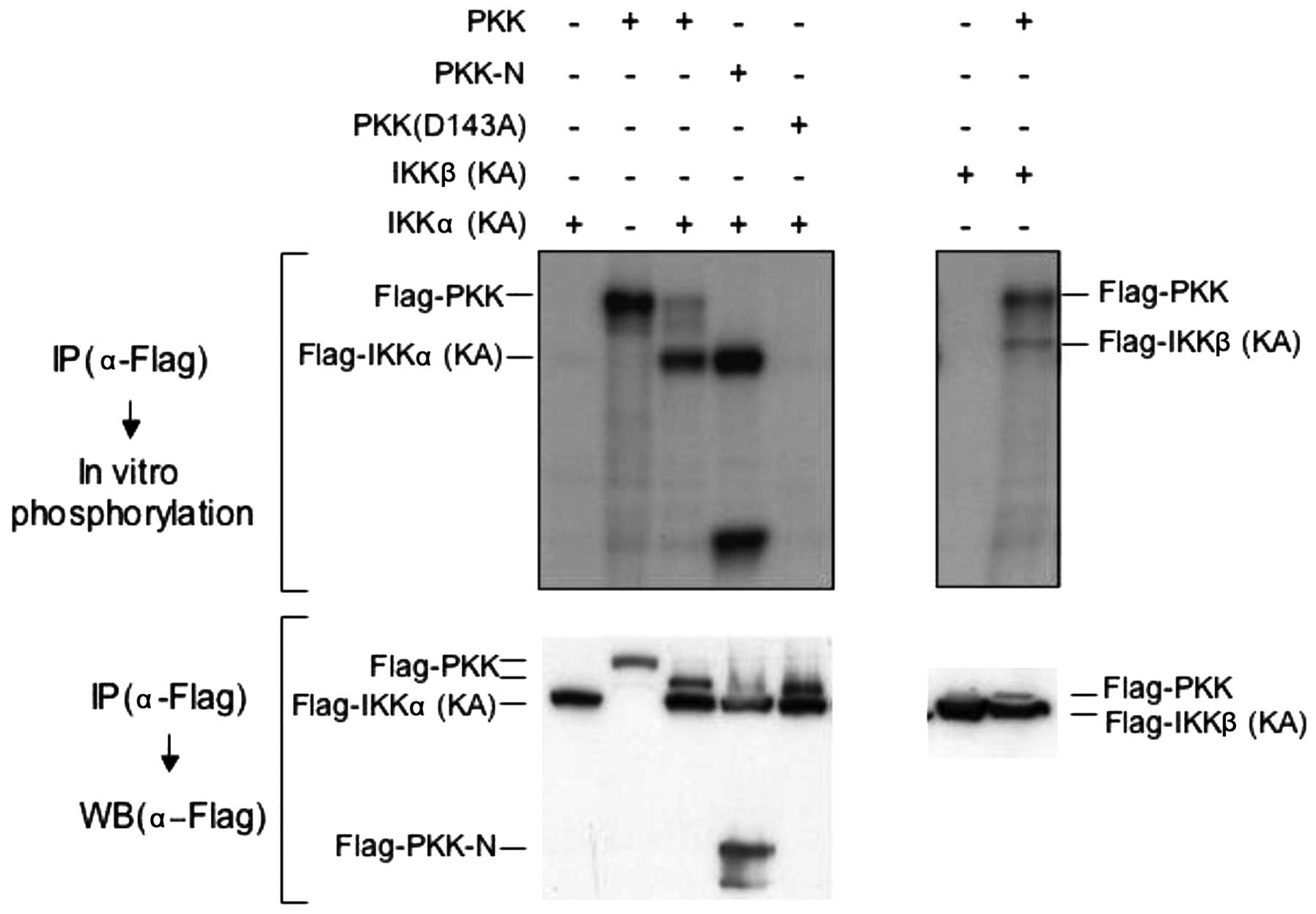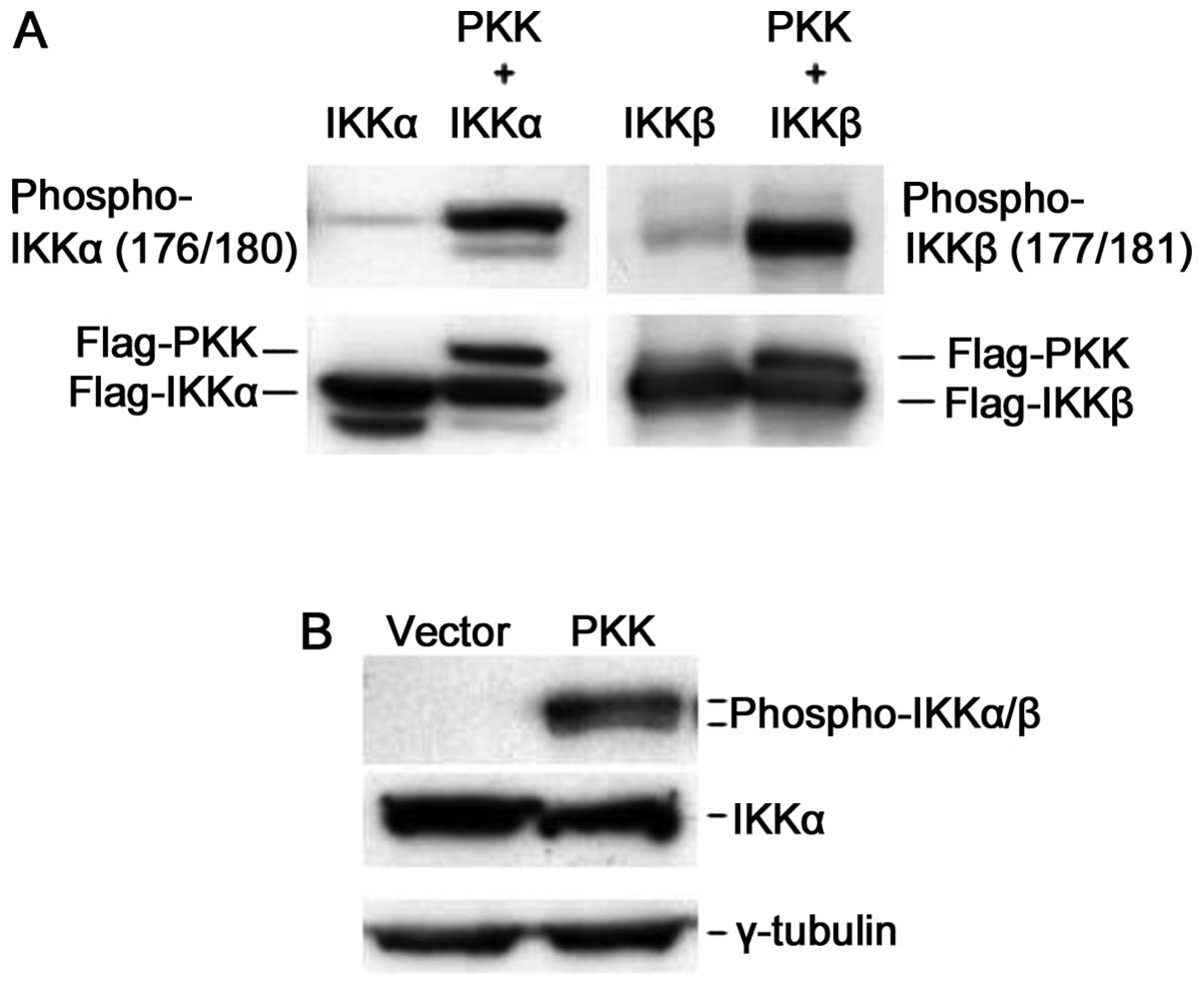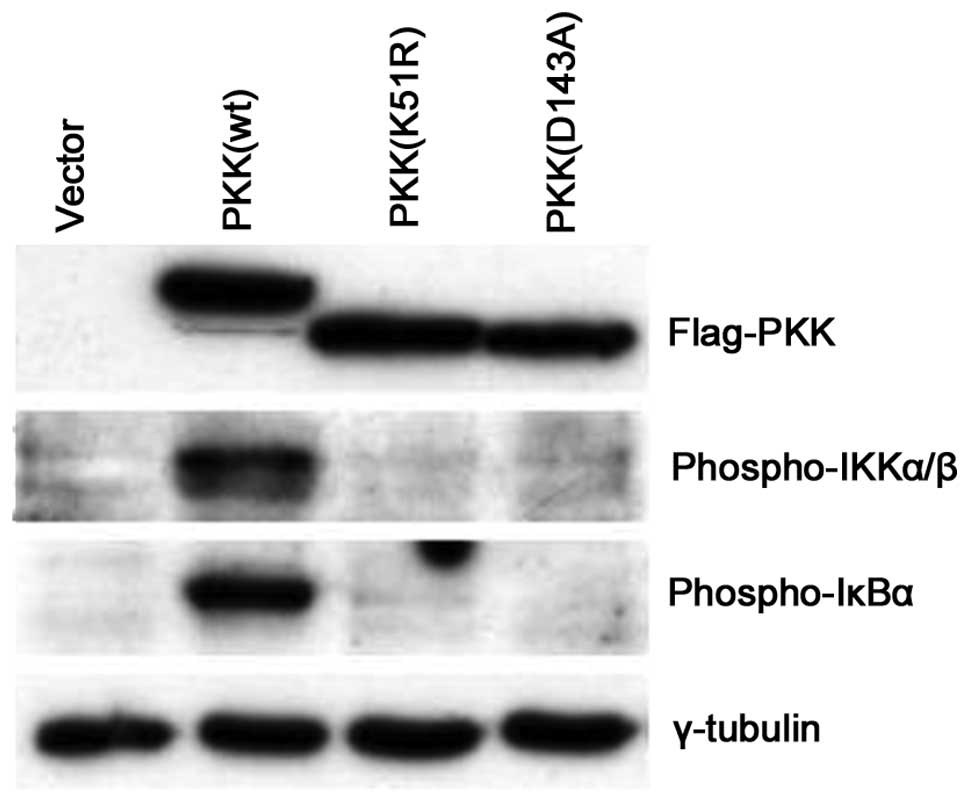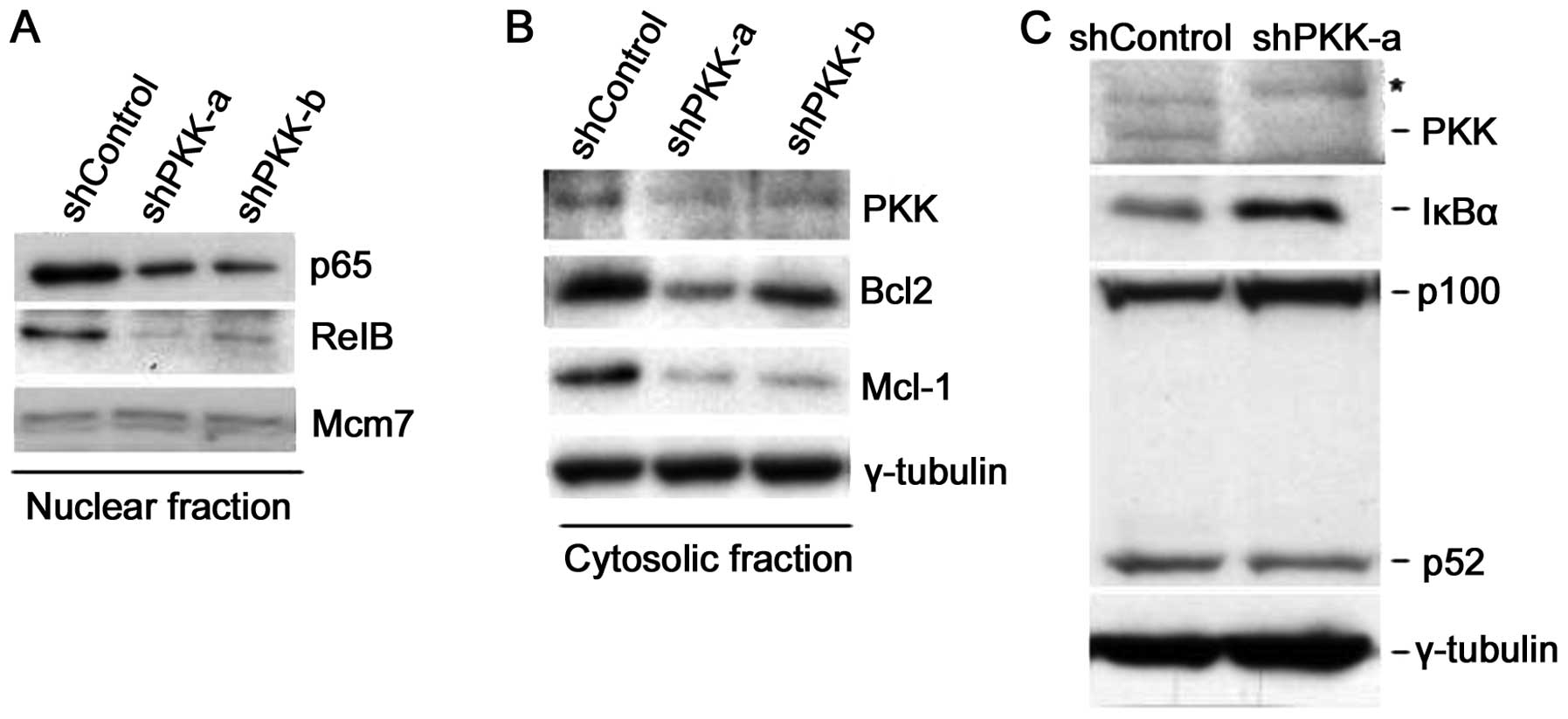Protein kinase C-associated kinase regulates NF-κB activation through inducing IKK activation
- Authors:
- Published online on: August 4, 2014 https://doi.org/10.3892/ijo.2014.2578
- Pages: 1707-1714
Abstract
Introduction
The transcription factor NF-κB regulates the expression of hundreds of target genes involved in immune response, inflammation, cell proliferation and survival (1–3). Mammals express five NF-κB family proteins: NF-κB1 (p105/p50), NF-κB2 (p100/p52), RelA (p65), RelB and c-Rel. NF-κB1 and NF-κB2 are produced as precursor proteins, p105 and p100, which are then processed into p50 and p52, respectively. While the processing of p105 to p50 appears to be constitutive, the processing of p100 to p52 is regulated. The NF-κB proteins form various homo- and hetero-dimers to generate functional NF-κB. In most normal unstimulated cells, NF-κB dimers are retained in the cytoplasm by IκB proteins. The IκB proteins interact, through their ankyrin repeats, with the Rel homology region (RHD) of NF-κB dimers. Such ankyrin repeats are also present in unprocessed NF-κB1 (p105) and NF-κB2 (p100), which act as IκB proteins that retain the Rel proteins in the cytoplasm (2,4,5).
Two NF-κB activation pathways, the classical and the alternative pathways, have been extensively characterized. In the classical NF-κB pathway (also known as the canonical pathway), the activated IκB kinase (IKK) complex, consisting of the catalytic subunits IKKα and IKKβ and the regulatory subunit IKKγ (also called NEMO), phosphorylates IκB proteins. This triggers IκB polyubiquitination and its subsequent degradation by the 26S proteasome. IKKβ and IKKγ are essential for the classical NF-κB activation pathway, while IKKα seems dispensable for the activation of this pathway in response to most tested stimuli. On the other hand, activation of the alternative NF-κB pathway (also known as the non-canonical pathway) depends on IKKα, but neither IKKβ nor IKKγ. In this alternative pathway, the active IKKα homodimer induces phosphorylation of NF-κB2/p100. The phosphorylated p100 is then polyubiquitinated and processed into p52. Activation of the classical NF-κB pathway predominantly results in active p50/RelA and p50/c-Rel dimers, while the alternative pathway leads to selective release of the p52/RelB complex. The released NF-κB dimers then translocate into the nucleus, bind target gene promoters and activate gene transcription (2,4,5).
Numerous NF-κB-activating cascades induced by extracellular stimuli converge on the activation of IKKα and IKKβ (2,4,5). This activation is regulated by the phosphorylation of two conserved serine residues (Ser176 and 180 in IKKα and Ser177 and 181 in IKKβ) located in their activation loops (6–8). Despite great progress in the understanding of signaling pathways controlling NF-κB activation, the molecular mechanisms underlying activation of IKK complexes induced by various signaling molecules remain to be fully elucidated.
Protein kinase PKK (also known as DIK and RIP4) was originally identified as a protein kinase Cβ and δ interacting protein (9,10). We previously showed that PKK physically interacts with co-transfected PKCβ and can be phosphorylated by PKCβ in vitro, suggesting that it may be a downstream target of PKCβ (10). We also reported that PKK affects cell survival and BAFF-mediated IKK phosphorylation and NF-κB activation in DLBCL (34). PKK belongs to the RIP kinase family and shares high sequence homology at the N-terminal kinase domain with other members of this gene family (9–11). Similar to other members of the RIP family, PKK was shown to activate NF-κB in transient transfection assays (12–14). Moreover, catalytically inactive mutants of PKK can block NF-κB reporter activation (13,14). These results suggest that PKK regulates NF-κB activation. It was reported that PKK-induced NF-κB reporter activation is inhibited by dominant-negative IKKα and IKKβ and that PKK failed to activate the NF-κB reporter in mouse embryonic fibroblasts (MEFs) deficient in IKKβ, suggesting that NF-κB activation by PKK requires IKK activity (14). How PKK regulates NF-κB activation has, however, remained elusive.
Here we have investigated the molecular mechanism by which PKK regulates NF-κB activation. Our results indicate that PKK activates NF-κB through both the classical and the alternative pathways by inducing phosphorylation of both IKKα and IKKβ. In addition, we show that PKK induces IKK activation primarily in a kinase-dependent manner.
Materials and methods
Cell culture, antibodies, and expression plasmids
HEK293, HEK293T and HeLa cells were cultured in Dulbecco’s modified Eagle’s medium (DMEM) supplemented with 10% of fetal bovine serum. Human diffuse large B cell lymphoma (DLBCL) SUDHL-6 cells were cultured in RPMI with 10% fetal bovine serum. Antibodies against IKKα, IKKβ, p65, Rel-B, Bcl2, Mcl-1 and MCM7 were from Santa Cruz Biotechnology, Inc. Antibody specific for human p100/p52 was from Upstate Biotechnologies. Antibodies against IκBα, phospho-IκBα (p-Ser32), phospho-IKKα (p-Ser180)/IKKβ (p-Ser181), and phospho-IKKα (p-Ser176/180)/IKKβ (p-Ser177/181) were from Cell Signaling Technology. Anti-HA tag antibody was from Covance Research Products. Antibodies specific for γ-tubulin and Flag-tag were from Sigma. Rabbit polyclonal anti-PKK antibody was raised against the peptide AHINLQSLKFQGGHGPAATLL (amino acids 759–779 of human PKK).
The pCMV5 plasmids expressing Flag-tagged human PKK, PKK-N and the catalytically inactive mutants of Flag-PKK (D143A) and Flag-PKK (K51R) were described previously (10,13). Expression plasmid for the N-terminal HA-tagged p100 was kindly provided by Dr Shao-Cong Sun. Expression plasmids for Flag-IKKα, Flag-IKKβ, Flag-IKKα (KA) and Flag-IKKβ (KA) were kindly provided by Dr David Goeddel (15). Plasmids for HA-IKKα and HA-IKKβ were generous gifts from Dr Michael Karin (8).
Transfection, immunoprecipitation, western blot analysis and in vitro kinase assays
The transfection, preparation of cell lysates, immunoprecipitation and western blot analysis were performed as previously described (10,16). For in vitro kinase assays, HEK293T cells were transfected with plasmids expressing the indicated Flag-tagged proteins. Forty hours post-transfection, the cell lysates were immunoprecipitated with the anti-Flag antibody (M2). The in vitro kinase assays were carried out in the presence of [γ-32P]ATP essentially as previously described (10,16). The kinase reaction products were analyzed by autoradiography following SDS-polyacrylamide gel electrophoresis.
RNA interference
To knockdown the expression of PKK in cultured human cell lines, we employed RNA interference with small hairpin RNAs (shRNAs) (17,18). Two targeting sequences (shPKK-a: 5′-GCTAGTGATGCATCATATC; and shPKK-b: 5′-TACCTCACTCACGAGA ) were selected and the PKK-specific shRNAs were expressed from the pRetro-H1 vector (Cellogenetics Inc.). The control shRNA construct (shControl) carries a random hairpin sequence: 5′-GTTCTCCGAACGAACGTGTCACG. To transiently suppress PKK expression, HEK293 and HeLa cells were transfected with an shPKK and shControl. Twenty-four hours after transfection, puromycin (2 μg/ml, the vector carries a puromycin-resistant gene) was added into the culture medium for 4 days to select transfected (PKK knocked-down) cells. To generate SUDHL-6 cells with PKK expression being stably suppressed, we infected SUDHL-6 cells with retroviruses expressing an shPKK or shControl. The transduced cells were selected with puromycin (0.5 μg/ml) for at least two weeks.
Results
Expression of PKK can activate the alternative NF-κB pathway as well as the classical NF-κB pathway
It was previously shown that overexpression of PKK activated NF-κB reporters and induced IκBα phosphorylation, suggesting that PKK can activate the classical NF-κB pathway (12–14). Whether PKK activates the alternative NF-κB pathway has not been explored. To address this issue, we transfected Flag-tagged PKK alone or together with IKKα, which is known to be involved in activation of the alternative pathway, into HEK293T cells and analyzed the processing of p100 (NF-κB2) to p52. As shown in Fig. 1A, while overexpression of PKK modestly increased level of endogenous p52, co-expression of PKK with IKKα greatly increased level of endogenous p52 with a concomitant decrease in the level of endogenous p100 (Fig. 1). Co-expression of PKK and IKKα also resulted in significant processing of the exogenous p100 into p52 (Fig. 1B). These results indicate that PKK, together with IKKα, can activate the alternative NF-κB pathway. Consistent with the activation of the alternative pathway, nuclear accumulation of endogenous RelB was increased following PKK overexpression (Fig. 1C). We also examined the effect of PKK overexpression on activation of the classical NF-κB pathway in our assays. Overexpression of PKK resulted in phosphorylation of endogenous IκBα (Fig. 1D), consistent with the previously reported results (12). In addition, we observed a concurrent decrease in the protein level of the endogenous IκBα and an increase in nuclear translocation of p65 (Fig. 1B), hallmarks of activation of the classical NF-κB pathway. Together, these results indicate that PKK can induce NF-κB activation through both the classical and the alternative pathways.
PKK interacts with IKKα and IKKβ
A crucial regulatory step in the activation of NF-κB pathways is the activation of IKK complexes (4,5,19). It was previously reported that activation of an NF-κB reporter by PKK overexpression was inhibited by dominant-negative mutants of IKKα and IKKβ and that PKK-mediated activation of the NF-κB reporter was diminished in mouse embryo fibroblasts deficient in IKKβ protein (14). These results suggest that NF-κB activation induced by PKK requires IKK activity. These observations, however, did not address directly whether PKK works upstream of IKKs or in parallel with IKKs to induce NF-κB activation. To investigate the relationship between PKK and IKKα and IKKβ, we examined whether PKK interacts with IKKα and IKKβ. We transfected HEK293T cells with the plasmid expressing Flag-tagged full-length PKK. The interaction between Flag-PKK with the endogenous IKKα and IKKβ was determined by co-immunoprecipitation experiments. Data presented in Fig. 2A show that both IKKα and IKKβ are present in the PKK immunoprecipitates, suggesting that PKK interacts with IKKα and IKKβ in mammalian cells. While PKK-N, which contains only the N-terminal kinase domain of PKK protein (aa1–320) and is capable of activating NF-κB (13), interacts with IKKα or IKKβ (Fig. 2B), the C-terminal domain of PKK (aa461–786) showed no interaction with IKK proteins (data not shown). These results indicate that the kinase domain of PKK mediates its association with IKKα and IKKβ.
PKK induces phosphorylation of IKKα and IKKβ in vitro and in vivo
The observation that PKK associates with IKKα and IKKβ prompted us to explore whether PKK acts upstream of IKKs. We first examined whether PKK can induce phosphorylation of IKKα and IKKβ in vitro. We transfected Flag-tagged PKK with a Flag-tagged kinase-inactive mutant of IKKα [IKKα (KA)] or IKKβ [IKKβ (KA)] (15) in HEK293T cells, and immunoprecipitated both PKK and IKKs with the antibody specific for the Flag-tag. Phosphorylation of the kinase-inactive IKK mutants in the immunoprecipitates was then carried out in vitro in the presence of [γ-32P]ATP. The kinase-inactive IKK mutants were used in this experiment to avoid their autophosphorylation so that phosphorylation of IKKs induced by PKK could be easily and unambiguously detected. As shown in Fig. 3, both PKK and PKK-N induced phosphorylation of IKKα and IKKβ in vitro, in addition to their autophosphorylation as we previously reported (10). In contrast, the catalytically-inactive PKK (D143A), although expressed at similar levels as PKK and PKK-N, was unable to induce the phosphorylation of co-immunoprecipitated IKKs (Fig. 3, and data not shown). Thus, PKK induces IKK phosphorylation in a kinase-dependent manner in vitro.
We next investigated whether expression of PKK activates IKK in vivo. Phosphorylation of IKKα and IKKβ at serine residues 176/180 and 177/181 (Ser176/180 and Ser177/181), respectively, controls their activation, and the levels of phosphorylation at these residues reflect the relative activity of these kinases (6–8,20,21). To analyze IKK activation, we examined the phosphorylation of IKKα and IKKβ at these serine residues following PKK overexpression. We expressed IKKα or IKKβ alone or together with PKK in HEK293T cells, and assayed phosphorylation of Ser176/180 and Ser177/181 of IKKα and IKKβ, respectively, using a commercially available antibody that is specific for both phospho-Ser176/180 of IKKα and phospho-Ser177/181 of IKKβ. While overexpression of IKKα or IKKβ alone showed some basal phosphorylation at Ser176/180 or Ser177/181, co-expression of PKK dramatically increased phosphorylation of IKKα and IKKβ at these serine residues (Fig. 4A). Overexpression of PKK also induced phosphorylation of the endogenous IKKα and IKKβ while it had no effect on the expression levels of IKK proteins (Fig. 4B). Taken together, these results indicate that PKK acts upstream of IKKs by inducing their phosphorylation, and thus activation.
PKK induces IKK activation in a kinase-dependent manner
It has been shown that several members of the RIP family, including RIP, RIP2 and RIP3, activate NF-κB through a kinase-independent mechanism (11,22–26). It was also reported that certain kinase-inactive PKK were capable of activating an NF-κB reporter, but at much lower efficiency than the wild-type PKK (13). Since we observed that a catalytically-inactive kinase failed to induce IKK phosphorylation in vitro (Fig. 3), we investigated whether PKK induces endogenous IKK phosphorylation in vivo in a kinase-dependent manner. In contrast to the effect of wild-type PKK on IKK activation, expression of two catalytically-inactive mutants of PKK (D143A and K51R) were unable to induce IKK phosphorylation or IκBα phosphorylation (Fig. 5). These data suggest that PKK induces endogenous IKK activation primarily in a kinase-dependent manner.
Suppression of PKK expression inhibits NF-κB activation via inhibition of IKK phosphorylation
To determine whether endogenous PKK is involved in IKK activation, we examined the effect of suppression of PKK expression by RNA interference on IKK activation. To knockdown the expression of PKK, we prepared two retroviral constructs that express small hairpin RNAs (shRNAs) (17,18) targeting two distinct sequences of human PKK (referred to as shPKK-a and shPKK-b). Suppression of PKK expression by either shPKK-α or shPKK-β in HeLa cells inhibited nuclear accumulation of p65 and RelB (Fig. 6A), indicating the requirement for PKK in activation of both the classical and the alternative NF-κB pathways. More importantly, knockdown of PKK resulted in decreased expression of Bcl2 and Mcl-1, known transcriptional targets of NF-κB (Fig. 6B). Suppression of PKK expression by shPKK in HEK293 cells also resulted in accumulation of IκBα and accumulation of p100 with a concomitant decrease in the level of p52 (Fig. 6C). Together, these results support the view that PKK regulates activation of both the classical and the alternative NF-κB pathways in mammalian cells.
Our data from in vitro IKK phosphorylation and PKK overexpression experiments suggest that PKK functions upstream of IKK (Figs. 3 and 4). To further test this idea, we investigated whether knockdown of PKK has any effect on IKK phosphorylation. Using NF-κB reporter assays, it was previously shown that PKK mediates NF-κB activation induced by PMA and ionomycin, known activators of protein kinase C (PKC) in mammalian cells (13,14). Thus, we examined whether suppression of PKK expression inhibits IKK activation induced by these PKC activators. As shown in Fig. 7A, IKK phosphorylation at Ser180/181 was rapidly increased upon PMA/ionomycin stimulation in HeLa cells expressing shControl. Knockdown of PKK, while having no effect on the expression levels of IKKα and IKKβ proteins, inhibited PMA/ionomycin-induced IKK phosphorylation at Ser180/181 (Fig. 7A). As our previous studies with transgenic mice expressing a catalytically inactive PKK suggested that PKK may be involved in B lymphocyte development (27), we examined whether PKK plays a role in NF-κB activation in a B-cell line. Suppression of PKK expression in human B-cell lymphoma SUDHL-6 cells resulted in inhibition of phosphorylation of IKKα and IKKβ induced by PMA/ionomycin (Fig. 7B). These results demonstrate that PKK regulates PMA/ionomycin-induced NF-κB activation through modulating phosphorylation of IKKα and IKKβ in various mammalian cell lines.
Discussion
We investigated the function of PKK in NF-κB activation. We show that PKK regulates both the classical and the alternative NF-κB activation pathways. We also explored the mechanism by which PKK regulates NF-κB activation. We demonstrate that PKK induces phosphorylation of Ser176/180 and Ser177/181 of IKKα and IKKβ, respectively. Together, these results indicate that PKK functions upstream of IKK in NF-κB activation pathways, extending the previous observation that activation of an NF-κB reporter induced by PKK overexpression requires IKKβ (14). Our finding also provides an explanation for the earlier report that PKK-deficient keratinocytes had similar but not identical defects as IKKα-deficient cells in keratinocyte differentiation (28), as loss of PKK function would affect activation of both IKKα and IKKβ.
Several members of the RIP family, such as RIP, RIP2 and RIP3, function upstream of IKK in NF-κB activation (reviewed in ref. 11). This study identifies PKK (RIP4) as another RIP family member that acts as an upstream regulator of IKK activation. However, unlike the other RIP family members, which regulate NF-κB activation in a kinase-independent manner, PKK appears to regulate IKK and NF-κB activation predominantly in a kinase-dependent manner. It was previously reported that certain kinase-inactive PKK mutants could activate, albeit at much lower efficiency than the wild-type PKK, an NF-κB reporter in transient transfection experiments (13), suggesting that PKK may also be capable of activating NF-κB through a kinase-independent pathway under certain circumstances. It has been shown that RIP1 and RIP2 seem to activate NF-κB through the classical pathway (11). Here we show that PKK can regulate the activation of both the classical and the alternative NF-κB pathways. Thus, PKK possesses some unique features among the RIP family members. The physiological stimuli that require PKK function for NF-κB activation remain to be determined. As PKK interacts with protein kinase C β and δ (9,10) and regulates NF-κB activation induced by PMA/ionomycin (Fig. 7), known protein kinase C activators, it is reasonable to speculate that PKK functions downstream of protein kinase C β and δ and that PKK may play a critical role in NF-κB activation pathways involving PKC function. Given that PKK regulates the activation of both the classical and the alternative NF-κB pathways in a variety of mammalian cells (Figs. 6, 7, and data not shown), it is possible that PKK also plays a role in NF-κB activating pathways independent of PKC function.
Activation of IKKα and IKKβ, which is manifested by their phosphorylation at Ser176/180 and Ser177/181, respectively, is crucial for NF-κB activation induced by a variety of extracellular stimuli. The molecular mechanisms underlying IKK activation, i.e., the kinases that directly phosphorylate IKKα and IKKβ, in response to various extracellular signals remain to be clarified (5). We showed that PKK associates with IKKα and IKKβ in vivo (Fig. 2), and that PKK can induce IKK phosphorylation both in vitro and in vivo (Figs. 3 and 4). We have expressed and purified His-tagged IKK proteins from insect Sf9 cells and were unable to detect phosphorylation of the IKK proteins in vitro by purified PKK expressed from a baculoviral vector in insect Sf9 cells (data not shown). Muto et al also reported that, as an unpublished result, purified PKK did not phosphorylate IKKα and IKKβ in vitro (14). Thus, it is possible that PKK may activate IKKα and IKKβ through an indirect mechanism. Additional experiments are needed to elucidate how PKK induces activation of IKKα and IKKβ. TGF-β activating kinase 1 (TAK1) and NF-κB-activating kinase (NIK) are kinases that have been shown to function upstream of IKKs, possibly through directly phosphorylating IKK kinases (6,20). PKK may induce activation of IKK through activating either one of these kinases. We are currently testing these possibilities.
Overexpression of a catalytically inactive mutant of PKK in transgenic mice inhibited the generation of pro-B cells, suggesting a role for PKK in B cell development (27). However, mice deficient in PKK exhibit normal B cell populations in all examined compartments (28,29), indicating that PKK is dispensable for B cell development in mice. In addition, activation of the classical NF-κB pathway induced by BCR, CD40 or TLR in PKK deficient B cells appears to be normal (29). Here we show that the knockdown of PKK inhibits NF-κB activation in human B lymphoma cell lines (Fig. 7B, and unpublished data). One explanation for these apparently contradictory observations may be that the function of PKK in B-cells can be compensated by other members of the RIP family. Alternatively, PKK may have acquired an essential role in NF-κB activation in malignant B lymphocytes. Additional experiments are required to resolve these issues.
Deregulation of NF-κB activation has been associated with numerous human diseases including cancer, chronic inflammation and autoimmune diseases (30–33). As PKK plays a critical role in NF-κB activation pathways, molecular elucidation of the mechanism of PKK function may provide new insights into mechanisms leading to abnormal NF-κB activation in human diseases, and may also facilitate the development of therapeutic agents for human diseases resulting from aberrant NF-κB activation.
Acknowledgements
We thank Michael Karin, David Goeddel and Shao-Cong Sun for plasmid constructs. This study was supported by a 2-Year Research Grant of Pusan National University to S.W.K.
References
|
Schreiber J, Jenner RG, Murray HL, Gerber GK, Gifford DK and Young RA: Coordinated binding of NF-kappaB family members in the response of human cells to lipopolysaccharide. Proc Natl Acad Sci USA. 103:5899–5904. 2006. View Article : Google Scholar : PubMed/NCBI | |
|
Bonizz G and Karin M: The two NF-kappaB activation pathways and their role in innate and adaptive immunity. Trends Immunol. 25:280–288. 2004. View Article : Google Scholar : PubMed/NCBI | |
|
Aggarwal BB: Nuclear factor-kappaB: the enemy within. Cancer Cell. 6:203–208. 2004.PubMed/NCBI | |
|
Yamamoto Y and Gaynor RB: IkappaB kinases: key regulators of the NF-kappaB pathway. Trends Biochem Sci. 29:72–79. 2004. View Article : Google Scholar : PubMed/NCBI | |
|
Hayden MS and Ghosh S: Signaling to NF-kappaB. Genes Dev. 18:2195–2224. 2004. View Article : Google Scholar : PubMed/NCBI | |
|
Ling L, Cao Z and Goeddel DV: NF-kappaB-inducing kinase activates IKK-alpha by phosphorylation of Ser-176. Proc Natl Acad Sci USA. 95:3792–3797. 1998. View Article : Google Scholar : PubMed/NCBI | |
|
Hu Y, Baud V, Oga T, Kim KI, Yoshida K and Karin M: IKKalpha controls formation of the epidermis independently of NF-kappaB. Nature. 410:710–714. 2001. View Article : Google Scholar : PubMed/NCBI | |
|
Delhase M, Hayakawa M, Chen Y and Karin M: Positive and negative regulation of IkappaB kinase activity through IKKbeta subunit phosphorylation. Science. 284:309–313. 1999. View Article : Google Scholar : PubMed/NCBI | |
|
Bahr C, Rohwer A, Stempka L, Rincke G, Marks F and Gschwendt M: DIK, a novel protein kinase that interacts with protein kinase Cdelta. Cloning, characterization, and gene analysis. J Biol Chem. 275:36350–36357. 2000. View Article : Google Scholar : PubMed/NCBI | |
|
Chen L, Haider K, Ponda M, Cariappa A, Rowitch D and Pillai S: Protein kinase C-associated kinase (PKK), a novel membrane-associated, ankyrin repeat-containing protein kinase. J Biol Chem. 276:21737–21744. 2001. View Article : Google Scholar : PubMed/NCBI | |
|
Meylan E and Tschopp J: The RIP kinases: crucial integrators of cellular stress. Trends Biochem Sci. 30:151–159. 2005. View Article : Google Scholar : PubMed/NCBI | |
|
Meylan E, Martinon F, Thome M, Gschwendt M and Tschopp J: RIP4 (DIK/PKK), a novel member of the RIP kinase family, activates NF-kappa B and is processed during apoptosis. EMBO Rep. 3:1201–1208. 2002. View Article : Google Scholar : PubMed/NCBI | |
|
Moran ST, Haider K, Ow Y, Milton P, Chen L and Pillai S: Protein kinase C-associated kinase can activate NFkappaB in both a kinase-dependent and a kinase-independent manner. J Biol Chem. 278:21526–21533. 2003. View Article : Google Scholar : PubMed/NCBI | |
|
Muto A, Ruland J, McAllister-Lucas LM, Lucas PC, Yamaoka S, Chen FF, Lin A, Mak TW, Nunez G and Inohara N: Protein kinase C-associated kinase (PKK) mediates Bcl10-independent NF-kappa B activation induced by phorbol ester. J Biol Chem. 277:31871–31876. 2002. View Article : Google Scholar : PubMed/NCBI | |
|
Woronicz JD, Gao X, Cao Z, Rothe M and Goeddel DV: IkappaB kinase-beta: NF-kappaB activation and complex formation with IkappaB kinase-alpha and NIK. Science. 278:866–869. 1997. View Article : Google Scholar : PubMed/NCBI | |
|
Zhao J, Dynlacht B, Imai T, Hori T and Harlow E: Expression of NPAT, a novel substrate of cyclin E-CDK2, promotes S-phase entry. Genes Dev. 12:456–461. 1998. View Article : Google Scholar : PubMed/NCBI | |
|
Hannon GJ and Rossi JJ: Unlocking the potential of the human genome with RNA interference. Nature. 431:371–378. 2004. View Article : Google Scholar : PubMed/NCBI | |
|
Huppi K, Martin SE and Caplen NJ: Defining and assaying RNAi in mammalian cells. Mol Cell. 17:1–10. 2005. View Article : Google Scholar : PubMed/NCBI | |
|
Li ZW, Rickert RC and Karin M: Genetic dissection of antigen receptor induced-NF-kappaB activation. Mol Immunol. 41:701–714. 2004. View Article : Google Scholar : PubMed/NCBI | |
|
Shim JH, Xiao C, Paschal AE, Bailey ST, Rao P, Hayden MS, Lee KY, Bussey C, Steckel M, Tanaka N, Yamada G, Akira S, Matsumoto K and Ghosh S: TA K1, but not TA B1 or TA B2, plays an essential role in multiple signaling pathways in vivo. Genes Dev. 19:2668–2681. 2005. View Article : Google Scholar | |
|
Saijo K, Mecklenbrauker I, Santana A, Leitger M, Schmed C and Tarakhovsky A: Protein kinase C beta controls nuclear factor kappaB activation in B cells through selective regulation of the IkappaB kinase alpha. J Exp Med. 195:1647–1652. 2002. View Article : Google Scholar : PubMed/NCBI | |
|
Yu PW, Huang BC, Shen M, Quast J, Chan E, Xu X, Nolan GP, Payan DG and Luo Y: Identification of RIP3, a RIP-like kinase that activates apoptosis and NFkappaB. Curr Biol. 9:539–542. 1999. View Article : Google Scholar : PubMed/NCBI | |
|
Kasof GM, Prosser JC, Liu D, Lorenzi MV and Gomes BC: The RIP-like kinase, RIP3, induces apoptosis and NF-kappaB nuclear translocation and localizes to mitochondria. FEBS Lett. 473:285–291. 2000. View Article : Google Scholar : PubMed/NCBI | |
|
McCarthy JV, Ni J and Dixit VM: RIP2 is a novel NF-kappaB-activating and cell death-inducing kinase. J Biol Chem. 273:16968–16975. 1998. View Article : Google Scholar : PubMed/NCBI | |
|
Kelliher MA, Grimm S, Ishida Y, Kuo F, Stanger BZ and Leder P: The death domain kinase RIP mediates the TNF-induced NF-kappaB signal. Immunity. 8:297–303. 1998. View Article : Google Scholar : PubMed/NCBI | |
|
Hsu H, Huang J, Shu HB, Baichwal V and Goeddel DV: TNF-dependent recruitment of the protein kinase RIP to the TNF receptor-1 signaling complex. Immunity. 4:387–396. 1996. View Article : Google Scholar : PubMed/NCBI | |
|
Cariappa A, Chen L, Haider K, Tang M, Nebelitskiy E, Moran ST and Pillai S: A catalytically inactive form of protein kinase C-associated kinase/receptor interacting protein 4, a protein kinase C beta-associated kinase that mediates NF-kappa B activation, interferes with early B cell development. J Immunol. 171:1875–1880. 2003. View Article : Google Scholar | |
|
Holland P, Willis C, Kanaly S, Glaccum M, Warren A, Charrier K, Murison J, Derry J, Virca G, Bird T and Peschon J: RIP4 is an ankyrin repeat-containing kinase essential for keratinocyte differentiation. Curr Biol. 12:1424–1428. 2002. View Article : Google Scholar : PubMed/NCBI | |
|
Moran ST, Cariappa A, Liu H, Boboila C, Shi HN, Holland PM, Peschon JJ and Pillai S: Protein kinase C-associated kinase is not required for the development of peripheral B lymphocyte populations. Mol Immunol. 43:1694–1699. 2006. View Article : Google Scholar : PubMed/NCBI | |
|
Karin M and Greten FR: NF-kappaB: linking inflammation and immunity to cancer development and progression. Nat Rev Immunol. 5:749–759. 2005. View Article : Google Scholar : PubMed/NCBI | |
|
Jimi E and Ghosh S: Role of nuclear factor-kappaB in the immune system and bone. Immunol Rev. 208:80–87. 2005. View Article : Google Scholar : PubMed/NCBI | |
|
Kim HJ, Hawke N and Baldwin AS: NF-kappaB and IKK as therapeutic targets in cancer. Cell Death Differ. 13:738–747. 2006. View Article : Google Scholar : PubMed/NCBI | |
|
Li Q, Withoff S and Verma IM: Inflammation-associated cancer: NF-kappaB is the lynchpin. Trends Immunol. 26:318–325. 2005. View Article : Google Scholar : PubMed/NCBI | |
|
Kim SW, Oleksyn DW, Rossi RM, Jordan CT, Sanz I, Chen L and Zhao J: Protein kinase C-associated kinase is required for NF-kappaB signaling and survival in diffuse large B-cell lymphoma cells. Blood. 111:1644–1653. 2008. View Article : Google Scholar : PubMed/NCBI |



